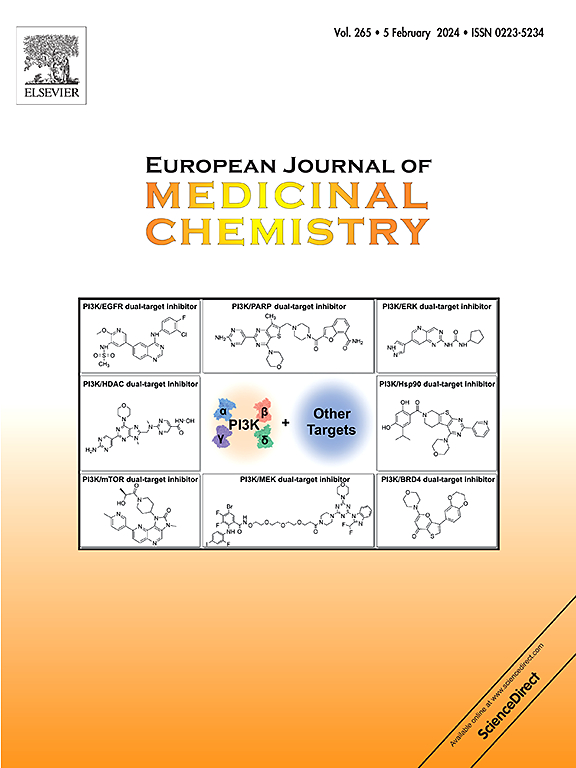The role of quinoline in the development of near-infrared fluorescent probes for diagnosis of Alzheimer's disease
IF 6
2区 医学
Q1 CHEMISTRY, MEDICINAL
引用次数: 0
Abstract
Alzheimer's disease (AD) is a common neurodegenerative disorder, having some negative impacts, affecting memory and other cognitive abilities, caused by injuries in brain cells. It is widely accepted that early diagnosis is essential for the successful management of AD. Since the current diagnosing strategies for imaging Aβ and tau proteins face limitations, near-infrared fluorescence (NIRF) has been pursued as alternative for in vivo applications. As described in recent dedicated literature, quinoline (and its analogues) is a valuable scaffold for creating new fluorescent probes due to its compact molecular size, the presence of a nitrogen atom in its ring which enhances coordination properties, and its capacity to form hydrogen bonds, as well as the easy chemical manipulation to tune several properties. In recent years, numerous fluorescent probes incorporating this moiety have been developed. This review focuses on the quinoline moiety as key component of several fluorescent probes, highlighting their design strategies, optical characteristics, and in vitro and in vivo performance, based on their distinct detection mode such as aggregation induced emission (AIE), intramolecular charge transfer (ICT) and twisted intramolecular charge transfer (TICT).


喹啉在阿尔茨海默病近红外荧光探针研究中的作用
阿尔茨海默病(AD)是一种常见的神经退行性疾病,有一些负面影响,影响记忆和其他认知能力,由脑细胞损伤引起。人们普遍认为,早期诊断对于AD的成功治疗至关重要。由于目前成像Aβ和tau蛋白的诊断策略面临局限性,近红外荧光(NIRF)已被寻求作为体内应用的替代方法。正如最近的专门文献所描述的那样,喹啉(及其类似物)是一种有价值的支架,用于制造新的荧光探针,因为它的分子尺寸紧凑,在其环中存在一个氮原子,可以增强配位性能,形成氢键的能力,以及容易的化学操作来调整几种性能。近年来,已经开发了许多包含该部分的荧光探针。本文综述了喹啉部分作为几种荧光探针的关键组成部分,重点介绍了它们的设计策略、光学特性以及体外和体内性能,基于它们不同的检测模式,如聚集诱导增强发射(AIE)、分子内电荷转移(ICT)和扭曲分子内电荷转移(TICT)。
本文章由计算机程序翻译,如有差异,请以英文原文为准。
求助全文
约1分钟内获得全文
求助全文
来源期刊
CiteScore
11.70
自引率
9.00%
发文量
863
审稿时长
29 days
期刊介绍:
The European Journal of Medicinal Chemistry is a global journal that publishes studies on all aspects of medicinal chemistry. It provides a medium for publication of original papers and also welcomes critical review papers.
A typical paper would report on the organic synthesis, characterization and pharmacological evaluation of compounds. Other topics of interest are drug design, QSAR, molecular modeling, drug-receptor interactions, molecular aspects of drug metabolism, prodrug synthesis and drug targeting. The journal expects manuscripts to present the rational for a study, provide insight into the design of compounds or understanding of mechanism, or clarify the targets.

 求助内容:
求助内容: 应助结果提醒方式:
应助结果提醒方式:


